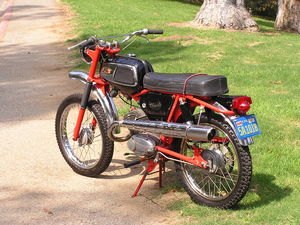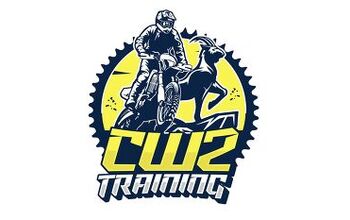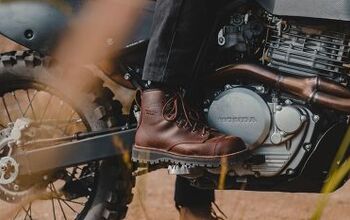First Bike the Second Time Around: MSCuddy's Jawa
We all remember our first motorcycle. We remember when we got it, how much it cost, and what it sounded like. Even what color it was. And we also remember certain idiosyncrasies that made it interesting to own and ride. In my case, it was a 1973 Jawa Trail 90, my first dual-purpose motorcycle.
In 1973, I was in the 10th grade and a rabid Jawa-CZ freak. I wore a different CZ jersey to school each day. I had CZ stickers plastered on every textbook and folder. I sported a CZ "hot-hat." I drew the CZ emblem on everything, even dogs (cats wouldn't hold still). My hamsters were named Barum and Jikov.
I was in the 10th grade and a rabid Jawa-CZ freak. I wore a different CZ jersey to school each day. I had CZ stickers plastered on every textbook and folder. I sported a CZ "hot-hat."
Of course, I didn't own a CZ (or Jawa), or hadn't even ridden one. But that didn't stop me from eating, drinking and living CZs. Like someone afflicted with Jawa Tourette's syndrome, I would blurt out obscure Jawa-CZ trivia to anyone who would listen. The names of factory riders, compression ratios, how many fins the new radial head had, etc. There were two other Jawa-CZ freaks at school and we'd gather at the same place every lunch to trade new commie tidbits. People thought we were strange, subversive even.
Around the tenth grade, my parent's worst nightmare came true and I got my learner's permit that allowed me to operate a motor vehicle during daylight hours with a licensed driver in the car. That rule didn't apply to motorcycles though. And since my two CZ buddies (Karl and Earl) had just gotten their parents to buy them new Honda SL100's, I started working on my parents for a new "enduro" motorcycle of my own.
My situation was special. My mom had divorced and moved back in with her parents. The decision of what motorcycle to purchase ultimately rested on my grandfather, a product of the great depression. Around the tenth grade, my parent's worst nightmare came true and I got my learner's permit that allowed me to operate a motor vehicle during daylight hours with a licensed driver in the car.Gramps was frugal, to say the least and after we visited many local motorcycle shops, it became clear that I'd have to mow lawns and deliver newspapers for at least 15 more years before I had enough money to buy a new Honda or Yamaha. Both went for the pricey sum of four hundred 1973 dollars out the door. It looked like I'd have to wait...
But that all changed a week later, when the next issue of Cycle News came out. There, in a 1/4 page advertisement in the classified section was perhaps the best motorcycle ad I'd ever seen:
We Have Obtained A Limited Quantity Of Jawa 90 Racers From The Factory. New-In-The-Crate Genuine Jawa Motorcycles For Sale At The Unbelievable Low Price Of $250.00 Each. Own One Of These Marvels Of Czech Engineering, Manufactured By The Holder OF 33 International World Titles, Jawa-CZ...
The ad showcased a black-and-white picture of a Jawa 90, with the camera angle pointed just right to highlight the radial head and trick-looking banana frame.
My grandpa was impressed. A new European motorcycle in the crate for half of what a Honda or Yamaha went for? So we got into Grandpa's '68 GTO and drove to the address listed. It turned out to be a big garage next to some railroad tracks in a run-down section of Van Nuys. Sitting in the middle of the dimly-lit garage at a card table was Mr. Whipsnade, counting $20.00 bills out of a lockbox and chomping on a cigar. Crates of new Jawa 90's were stacked to the ceiling. "You know my lad, all the factory Jawa-CZ riders started off on this very model, and that Dave Bickers himself had once...blah blah..."
"Come in, come in please! I see you want to purchase a new Jawa 90 Racer. You couldn't have made a better choice. Here, have some doughnuts..."
Twenty minutes later I was the proud owner of a new Jawa 90. As Mr. Whipsnade "I rode the snot out of that little Jawa, and when I finally sold it 10 years later, it had a Honda 150 rear wheel, the frame was bent and everything was held together with hose clamps and duct tape."helped us load the crated Jawa into the Pontiac's trunk, he kept up the sales spiel: "You know my lad, all the factory Jawa-CZ riders started off on this very model, and that Dave Bickers himself had once...blah blah..."
I wasn't listening, instead fantasizing about zipping along some ISDT trail in the Black Forest, on time and on gold.
It was amazing. 170 lbs. wet and 11 horsepower produced a fast little motorcycle. But that's when it ran.
We got the crate back home and carefully opened it, making sure not to scratch or otherwise damage the red-and-black beauty inside. After a few hours of head scratching and bloody knuckles, Gramps had the Jawa together and running, more or less.
It was amazing. 170 lbs. wet and 11 horsepower produced a fast little motorcycle. But that's when it ran. This was the motorcycle that introduced me to the greasy handshake of motorcycle maintenance. It required constant attention in order to run, and after a while I didn't leave home without a tow rope. I could see now why the good folks at Jawa put such a giant tool kit under the seat. You needed it, and more. Hell, looking back you needed a portable lathe and a support truck.
But for a 15-year-old kid with a Jawa-CZ attitude, it was bliss. This was a "real" motorcycle, not some gaudy pinstriped street-bike with a chrome high pipe. I sneered at my buddies' Japanese bikes (until I needed a tow). I rode the snot out of that little Jawa, and when I finally sold it 10 years later, it had a Honda 150 rear wheel, the frame was bent and everything was held together with hose clamps and duct tape. It seemed after 10 years of "modifications" it became reliable as a brick -- a very slow brick -- but I rode it everywhere. I often wonder what happened to it when I use a disposable lighter.
Not too long ago I found a Jawa Trail 90 online, for sale in California from a private collection. After some wrangling I managed to trade a box of Cushman motorscooter parts for it. It has 272 miles on the clock, and hasn't been started in 33 years. Maybe I'll just fill this one full of formaldehyde, and bolt it to a wall in the den. Save myself some grief.
Sure. Anyone know where I can get some Pal sparkplugs?
This was a "real" motorcycle, not some gaudy pinstriped street-bike with a chrome high pipe. I sneered at my buddies' Japanese bikes (until I needed a tow).
Riding Impressions of a 1973 Jawa 90.
Here are some of my impressions of riding a Jawa Trail 90, as an adult, without any inherent Jawa-CZ bias. I'm trying to be as impartial as possible here, 30 years after the fact. Please excuse any outright lies or misrepresentations. Jawa-CZ addictions are hard to overcome.
Sitting in the saddle, one is impressed with the motorcycle's compact size and light weight. It feels more like a moped than a motorcycle. The bike is very narrow, with the exception of the rubber-covered rigid footpegs that got the nickname "ankle breakers" for good reasons. The tank is hump backed, black with chrome slab sides and rubber knee pads. In Jawa-CZ tradition, the shifter is made from tool steel, and sports a giant lump of rubber on the end. Shift travel is about four inches. The rear brake pedal sticks way out in the breeze, and is hard to miss. Nothing protects the vulnerable engine cases, which are completely exposed due to the banana-style backbone frame that uses no front down tubes.
One unusual feature is the rotary high beam-low beam switch that also doubles as the horn button, located in the clutch lever housing.
The ignition switch is on the left side panel, and is activated with a stamped steel key that looks like it might have been hand beaten from old C-ration cans by political prisoners. It has four settings; ON, LIGHT, PARKING LIGHT and OFF. A 24mm downdraft Jikov carburetor is on top of the right side case, and feeds the rotary valve. It has both a flapper-style choke plate in the air horn, and a tickler on the float bowl.
One unusual feature is the rotary high beam-low beam switch that also doubles as the horn button, located in the clutch lever housing. Very trick. Handgrips are cross-hatched hard plastic, and are real blister producers. The horn is a 1930's Jawa classic mounted under the tank, and emits only a feeble bleat. It also weighs about 3 pounds.
The headlight is bullet-shaped, and sports a tiny Pal speedometer/odometer that's driven off the countershaft sprocket. At anything over five mph the speedo does a bad windshield wiper imitation, and becomes useless. The tail light is a Lucas rip-off, small and unobtrusive.
Another interesting feature is the use of a printed circuit board to connect the wiring harness. Electrics are handled by the fabled alternator charged battery-coil ignition, with rectifying done by a Zener Diode (that quits working after about a month). Wire insulation is that old rubbery stuff that catches fire easily and drips hot burning plastic and vapo-gas on exposed skin, so be careful and disconnect the battery when you work on the wiring. Whether you like it or not, you will work on the wiring.
Let's swing out the kick starter, and see what this minuscule communist weapon of mass destruction can do. But first we must turn on the Jikov gas tap and flood the motor via the "tickler" on the carburetor. This method of starting is frowned upon by the California Air Resources Board. All those free range hydrocarbons floating around...
After about three or four kicks the motor blubbers to life. The exhaust is very quiet, and the only real noises you hear are the whoosh from the rotary valve and the tools rattling around under the seat. A long prod up on the shifter nudges the bike into first gear, and you're underway. The Jawa 90 uses a one up-four down shift pattern, and it works pretty well once you get used to it. With the legendary Jawa-CZ gearbox, you can stomp it into the next gear with or without the clutch; it doesn't matter. "The bike tops out at around sixty, but you get there damn fast for a 90cc bike. With 11 horsepower on tap and 170 lbs wet you can see why."
The first four gears tap out quickly, and soon you're in fifth, whooshing and clanking along (the tools, remember). Short-shifting seems to work best. The bike tops out at around sixty, but you get there damn fast for a 90cc bike. With 11 horsepower on tap and 170 lbs wet you can see why.
Slowing down is another matter, as the brakes suck. They are terrible. The front and rear wheels interchange, and have the same hubs. Both brakes are overburdened, and as delivered from the factory are so out-of-arch that under hard use, they make even more noise than the horn. Also, the spokes are made out of hardened cheese, or some other past-due dairy product, as they loosen and break easily. I suspect the weird flange angle on the hubs has something to do with it. (note: I ruined the rear wheel on my original Jawa 90 in about 2 months of hard riding, and replaced it with an indestructible 16 inch Honda 150 Dream Cycle unit).
Handling is very good. You can throw the Jawa around like a bicycle. The only limiting factors under hard riding are the front forks, as they are under-dampened and prone to flexing and bottoming. The rear shocks are acceptable, if only to keep the rear wheel off the fender. Also, in slow going the rigid foot pegs catch stumps and roots, and stop the bike cold. This also sends your crotch into the hump on the gas tank. Ouch. Hello Vatican Boy's Choir.
The swing arm has rubber bushings, and flexes like a boa constrictor. But you don't notice the flexing, because you're having too much fun, listening to that little motor whooshing and grunting along. The stock 2.75 x 18 Barum trials tires do a respectable job, but are too small, even for a bike of this size. And because of that giant down-draft Jikov carburetor, gas mileage is abysmal, right down there with air-conditioned Buick Estate Wagons.
Handling is very good. You can throw the Jawa around like a bicycle.
But when everything is working and you're buzzing along, passing cars and people are waving, the Jawa flows. The whoosh from the rotary valve, the clanking of the tools under the seat, the light weight and neat power, it all cancels out the bad and fills your head with good.
Such is the 1973 Jawa Trail 90, a bike full of paradoxes. It's like the ying and yang of motorcycles, for every good idea, there's an absurdly dumb one. Take for instance:
Every nut and bolt is a top-quality hardened item, even the rigid foot pegs.
The air intake goes through the frame, and exits under the tank, but uses a thimble-sized paper filter.The crankshaft is supported by four main bearings (double on each side), but the seals are internal, and require that the cases be split for replacement.You have a neat quick-change rear hub, but the wheel assembly is crap.Gas cap is wide and off-set, but impossible to remove without a pair of pliers.Front and rear wheels interchange, but are worthless to begin with.The list goes on and on. Sadly, it seemed for the youth dual-sport buying public of the early 1970's, the Jawa Trail 90 missed the mark. Unfortunately, for us less-fortunate kids, it was our first motorcycle. And we never forget the first one, do we? Let's see, if I move the picture over the television a few feet to the left, I can bolt it right above the sofa...
More by Matt Cuddy, MOron
































Comments
Join the conversation